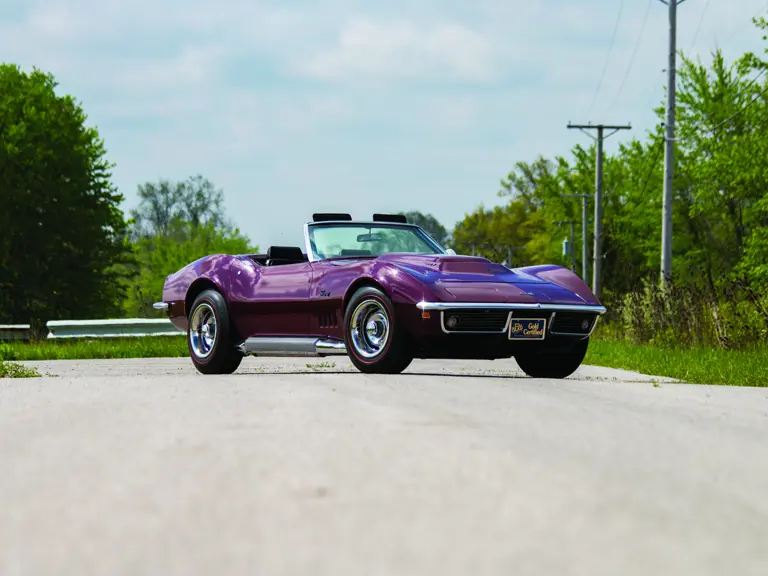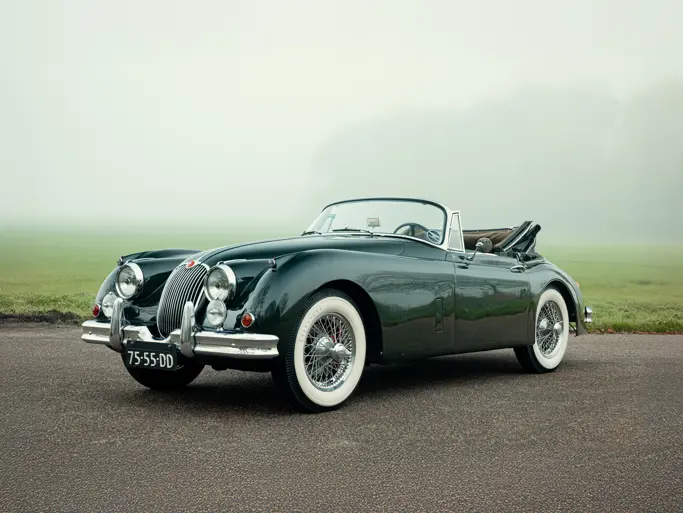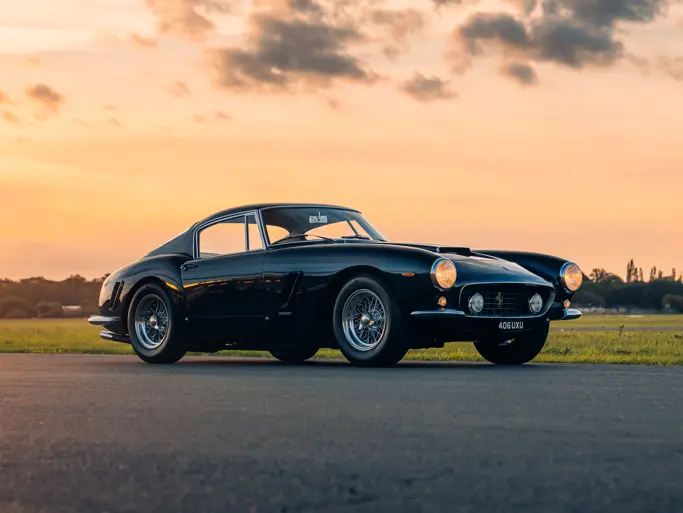
1969 Chevrolet Corvette Stingray L88 Convertible
{{lr.item.text}}
$650,000 - $750,000 USD | Not Sold
{{bidding.lot.reserveStatusFormatted}}
- 427-cid, 430-hp (advertised) 500-550 per L88 experts
- M22 Rock Crusher close-ratio heavy-duty four-speed transmission
- Aluminum heads, J56 big brakes among factory special equipment
- Comprehensive frame-off restoration by L88 experts
- Tank sticker, Bloomington Gold, NCRS Top Flight amongst certifications
- Also Muscle Car & Corvette Nationals recognitions
- Factory side pipes and radio delete
- Meticulous, documented & correct
- L88 among the most desirable of all Corvettes
- One of 116 built in 1969; only 216 over three years
With this one beautiful exception of engineering, there was no such thing as an American sports car. Chevrolet’s L88 Corvette was launched – or more properly launched itself – as a Cobra beater. It’s always been the “800-pound gorilla” of Corvettes, because it’s explosively intractable (the real horsepower figure tops 500), and an L88 holds an irresistible fascination for every collector who hungers to master one.
In 1966, Chief Engineer Zora Arkus-Duntov was frustrated by watching big-block Cobras run away from his Corvettes and went to the NASCAR parts bin to solve the problem. An aluminum head, 427-cid V-8 was dropped into a Corvette coupe with big brakes and heavy duty suspension, given to Roger Penske, and sent to the 1966 Daytona 24-hour race.
Dick Gulstrand and Ben Moore won the GT class (12th overall) and repeated the trick at the 12 Hours of Sebring, when they were 9th overall. It was all a warm-up for the 1967 24 Hours of Le Mans endurance race. In the Le Mans Trials, a near-stock L88 managed 171.5-mph on the Mulsanne Straight and led the race for almost 12 hours before throwing a rod.
Back home, the cars were a thunderous force on U.S. race tracks for almost 10 years, winning 16 SCCA national A- and B-Production titles. Jerry Thompson and Tony DeLorenzo won 11 straight races to take the SCCA A-Production class in 1969.
Of course, to be eligible for SCCA A-Production and FIA GT, the L88 package had to be factory built and street legal, so RPO L88 was added to the option list, and the cars were built on the St. Louis production line. There weren’t many though: 20 in 1967, 80 in 1968 and 116 in 1969, for a total of only 216. This amazing example represents one of the 116 built in 1969 with an option cost of $1,032.15 on a car with a base price of approximately $4,500; a massive uptick in percentage of cost.
There was a reason for that – a 500-hp racing package is a handful on the street. Sure, you got F41 heavy duty suspension, J56 big brakes and aluminum radiator, but the list of what you didn’t get was much longer: no radio, heater, air conditioning, power windows, or power steering. Even the fan shroud was omitted because it interrupted airflow over 80-mph. This, of course, meant the car ran hot around town – like you – pumping the King Kong clutch and shifting the M22 “rock crusher” four-speed with its straight-cut racing gears. This equipment was necessary to get the phenomenal horsepower to the ground without waste.
Under the hood, there were no compromises. L88s were built and blueprinted in a “clean room” at the Tonawanda, New York plant. Can-Am-sourced aluminum heads sported massive 2.19-inch intake and 1.84-inch exhaust valves. Compression was 12.5:1 and the carburetor was a huge 850-cm Holley that could inhale birds. The extreme solid-lifter cam had .54-inch lift on the intake and .56-inch on the exhaust, while the duration was 354 degrees on the intake and 360 degrees on the exhaust. Duntov was reportedly disappointed that many L88s never saw a race track to show off their prodigious attributes.
Road & Track magazine considered that, without question, the Corvette was one of the best handling front engine production cars in the world in 1969 and that the four-wheel disc brakes were also in the same classification. When you have the mechanical prowess of this machine, you’ll be glad for every other factory augmentation to corral this brute.
This exceptional and rare L88 has been body-off restored and is presented in show condition. It is finished in Burgundy with Black interior and a tan soft-top. The Corvette has an optional black vinyl-covered removable hardtop, factory side exhaust, radio delete, power brakes and transistorized ignition. The main focus is rightfully on the 427-cid, 430-hp L88 V-8 with aluminum heads, M22 Rock Crusher close-ratio heavy-duty transmission, J56 special heavy-duty brakes, plus the F41 special front and rear suspension.
While the horsepower was rated at 430 to deter prospective orders, as prospective owner's would opt for the 435-hp Tri-power engine; the horsepower of the L88's is more commonly thought to be in the phenomenal range of around 550 horsepower. This exceptional L88 has received two comprehensive frame-off restorations by one of the leading L88 restorers and Bloomington Gold judges, Tim Thorpe, and a recent chassis restoration by renowned L88 Corvette expert, Kevin Mackay of Corvette Repair. This car is fully documented by the "tank sticker" that was carefully removed off the car, as well as previous titles and registration and an affidavit from the previous owner who uncovered the car in 1986. This highly-prized L88 is in the L88 Registry and has been at the L88 Bloomington Gold events over the past 27 years.
Not only is the L88 presented in show condition, it is a proven winner with accolades as a Triple Crown Award Winner; Bloomington Gold Certified; Bloomington Gold Special Collection "Earthquake 88;" 2008 Bloomington Gold L88 Invasion Special Collection; NCRS Top Flight Certified and is a Chevy-Vette Fest Gold Spinner Award Winner. The L88 has also garnered awards at the Muscle Car and Corvette Nationals with Gold Concours, Triple Diamond and was part of the 2009 L88 Invitational.
We heard the L88 Corvette was a power hungry machine; let this one take over.


 | Santa Monica, California
| Santa Monica, California


